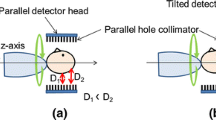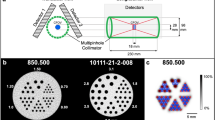Abstract
In recent years, dedicated cardiac single photon emission computed tomography (SPECT) systems have been undergoing a profound change in design with multiple detectors and various angles between the modules to improve the sensitivity and the resolution by reducing the distance between the heart and the detector. The performance of a dual-head cardiac SPECT for small-animal imaging was characterized as a function of the angle between two detector heads by using GATE simulations, and simulation data were validated with experimental results. Each detector head consists of 50 × 50 × 6 mm3 NaI(Tl) optically coupled to a Hamamatsu H8500 position sensitive photomultiplier (PSPMT) and a low-energy high-resolution parallel-hole collimator (LEHR, septal thickness: 0.2 mm, diameter: 1.9 mm). The distance between the collimator surface and the center of rotation was set as 20, 20, 20, 25, or 31.5 mm for 70°, 80°, 90°, 100°, or 110°, respectively, based on a 40-mm field of view (FOV). A point source and a rat cardiac phantom of Tc-99m in scattering media were simulated. Projection data were acquired for 180 angular views in steps of 2° and were reconstructed by using a filtered back-projection algorithm. Results demonstrated that the angle between the detector heads did not make a big difference in the image quality when scattering media were not presented, but the dual heads in the 80° geometry provided the best spatial resolution in the cardiac phantom study. The peak-to-valley ratio between the myocardial wall and the cavity was measured as 1.87, 11.01, 3.28, 3.40, or 2.46 for 70°, 80°, 90°, 100°, or 110°, respectively. Experiments were performed with a dual-head SPECT in the 80° geometry, and the results agreed well with these from the simulations. In this study, the impact of the angle between dual detector heads on the imaging performance was evaluated, and the optimal angle was derived for a dedicated cardiac SPECT.
Similar content being viewed by others
References
R. R. Russell, Curr. Prob. Cardiology 31, 557 (2006).
M. Bocher et al., Eur. J. Nucl. Med. 37, 1887 (2010).
J. M. Links, Eur. J. Nucl. Med. 20, 440 (1993).
J. M. Links et al., Eur. J. Nucl. Med. 6, 548 (1995).
M. I. Travin, Semin. Nucl. Med. 3, 182 (2011).
R. L. Eisner et al., J. Nucl. Med. 11, 1717 (1986).
T. L. Faber, J. Nucl. Cardiol. 3, 292 (1994).
X. He et al., J. Nucl. Cardiol. 3, 345 (2006).
H. O. Anger, Rev. Sci. Instrum. 29, 27 (1958).
S. Jan et al., Phys. Med. Biol. 49, 4543 (2004).
J. T. Bushberg et al., The Essential Physics of Medical Imaging (Lippincott Williams & Wilkins, North American Edition, 2011), p. 712.
Author information
Authors and Affiliations
Corresponding author
Rights and permissions
About this article
Cite this article
An, S.J., Kim, HI., Lee, C.Y. et al. Optimization of the angle between detector modules in a dual-head cardiac SPECT. Journal of the Korean Physical Society 62, 147–151 (2013). https://doi.org/10.3938/jkps.62.147
Received:
Accepted:
Published:
Issue Date:
DOI: https://doi.org/10.3938/jkps.62.147




